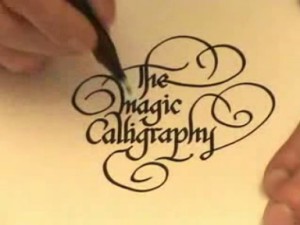Calligraphy
 Calligraphy is a type of visual art. It is often called the art of fancy lettering (Mediavilla 1996: 17). A contemporary definition of calligraphic practice is “the art of giving form to signs in an expressive, harmonious and skillful manner” (Mediavilla 1996: 18).
Calligraphy is a type of visual art. It is often called the art of fancy lettering (Mediavilla 1996: 17). A contemporary definition of calligraphic practice is “the art of giving form to signs in an expressive, harmonious and skillful manner” (Mediavilla 1996: 18).
The story of writing is one of aesthetic evolution framed within the technical skills, transmission speed(s) and material limitations of a person, time and place (Diringer 1968: 441). A style of writing is described as a script, hand or alphabet.
Modern calligraphy ranges from functional hand-lettered inscriptions and designs to fine-art pieces where the abstract expression of the handwritten mark may or may not compromise the legibility of the letters (Mediavilla 1996). Classical calligraphy differs from typography and non-classical hand-lettering, though a calligrapher may create all of these; characters are historically disciplined yet fluid and spontaneous, at the moment of writing.
Calligraphy is very useful for school children for their projects. Calligraphy continues to flourish in the forms of wedding and event invitations, font design/typography, original hand-lettered logo design, religious art, announcements/graphic design/commissioned calligraphic art, cut stone inscriptions and memorial documents. It is also used for props and moving images for film and television, testimonials, birth and death certificates, maps, and other works involving writing (see for example Letter Arts Review; Propfe 2005; Geddes and Dion 2004).
Some of the finest works of modern calligraphy are charters and letters patent issued by monarchs and officers of state in various countries.
